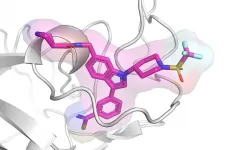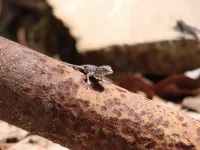Artificial intelligence identifies the tiger mosquito from photos in the Mosquito Alert
Artificial intelligence, combined with citizen science, will provide real-time detection of the tiger mosquito and will allow faster control of this desease transmitter. The deep learning algorithm is able to correctly identify 96% of the photographs
2021-05-14
(Press-News.org) Researchers from Mosquito Alert (who belong to CEAB-CSIC, CREAF and UPF) together with researchers from the University of Budapest have shown that an artificial intelligence algorithm is capable of recognizing the tiger mosquito (Aedes albopictus) in the photos sent by Mosquito Alert users.
The results of the study published in Scientific Reports have been obtained by applying deep learning technology or deep learning, an aspect of artificial intelligence that seeks to emulate the way of learning of humans and that has previously been used in the health field to interpret medical images (X-rays of patients with COVID19 to detect pneumonia, or facial features to detect heart disease, among others). Deep learning needs a lot of training data for the machine to learn.
John Palmer: "The initial idea is to get the machine to classify the simplest photos, and leave the task of identifying the most problematic images that require consensus to the experts".
In the case of the Mosquito Alert app, these images have been sent by the public and labeled by the project experts as "tiger mosquito" or "no tiger mosquito" for years. Specifically, the study used 7,168 classified photographs of mosquitoes that the project participants had sent between 2015 and 2019. After training, the algorithm has been able to correctly classify 96% of the photographs of this insect.
"The initial idea is to get the machine to classify the simplest photos, and leave the task of identifying the most problematic images that require consensus to the experts. As the artificial system learns from the classifications of the experts, we will be able to expand the range of automatically cataloged species ", explains John Palmer, UPF researcher and co-director of Mosquito Alert.
More predictability
This milestone can mark a before and after in the surveillance and monitoring of the tiger mosquito and other mosquitoes capable of transmitting diseases. "We are training a social immune system against these mosquitoes. The faster the threat is detected, the faster it can be acted upon ", comments Frederic Bartumeus, co-director of Mosquito Alert and ICREA researcher at CEAB-CSIC and CREAF. On the one hand, the citizen science of Mosquito Alert allows anyone to be part of this new social immune system and contribute a massive number of photos of mosquitoes, on the other, artificial intelligence allows, to accelerate the classification process of the received photos and thus help public health experts make better and faster decisions about mosquito management.
"In times of greatest need, such as in the months of greatest mosquito activity or in a context of epidemiological crisis, artificial intelligence can help us so that the system can absorb a greater amount of information, controlling its quality at all times, which it is key if the data is to be used for decision-making in public health ", adds Frederic Bartumeus.
Automating saves lives
The presence of the tiger mosquito in Spain poses a threat to public health. Millions of people are affected by its presence and are exposed to the risk of transmitting diseases such as dengue or chikungunya. In Europe, the tiger mosquito has been implicated every year since 2007 in small locally transmitted outbreaks of these viral diseases for which no vaccines are available. The only preventive measure is to control the mosquitoes that transmit them. Assessing the risk and the necessary action measures to mitigate it requires having accurate information on tiger mosquito populations, a costly and laborious task that requires manual placement and inspection of traps and their subsequent analysis in the laboratory where the insects are identified. A methodology that is not feasible to cover large geographic areas.
Mosquito Alert's citizen science methods, which allow anyone to report the presence of a mosquito through a mobile application available on Android and iOS, is an alternative that makes it easy to cover large geographic areas throughout the mosquito season. Since 2015, the initiative receives thousands of photographs every year that help estimate the abundance of mosquitoes. However, this large volume of photographs continues to be classified by visual examination by expert entomologists, a task that requires time and years of experience. Integrating artificial intelligence into this process can speed up classification and thus develop near-real-time hazard maps that improve tiger mosquito management.
Roger Eritja, CREAF scientist and Mosquito Alert entomological director, clarifies the limitations of artificial intelligence: "It will take time until a machine can have the same capacity as an expert eye, especially for other less characteristic species than the tiger mosquito. In Spain, 62 species of mosquitoes have been described, many of which currently cannot be classified from an image, but must be examined under a microscope. In some other cases, even a genetic analysis is required to identify them ".
INFORMATION:
The study is part of the Versatil Emerging infectious disease Observatory (VEO) project coordinated by Marion Koopmans from the Erasmus Universitair Medisch Centrum (EMC) Rotterdam, The Netherlands,, and funded by the European Commission's Horizon2020.
Reference work:
Balint Armin Pataki,
Joan Garriga,
Roger Eritja,
John R. B. Palmer,
Frederic Bartumeus &
Istvan Csabai (February 2021) "Deep learning identification for citizen science surveillance of tiger mosquitoes". Scienfific Reports 11, art núm. 4718
https://doi.org/10.1038/s41598-021-83657-4
ELSE PRESS RELEASES FROM THIS DATE:
2021-05-14
Of the over 400 climate scenarios assessed in the 1.5°C report by the Intergovernmental Panel on Climate Change (IPCC), only around 50 scenarios avoid significantly overshooting 1.5°C. Of those only around 20 make realistic assumptions on mitigation options, for instance the rate and scale of carbon removal from the atmosphere or extent of tree planting, a new study shows. All 20 scenarios need to pull at least one mitigation lever at "challenging" rather than "reasonable" levels, according to the analysis. Hence the world faces a high degree of risk of overstepping the 1.5°C limit. The realistic window for meeting the 1.5°C target is very rapidly closing.
If all climate mitigation levers are pulled, it may still be possible ...
2021-05-14
The protein made by the ASH1L gene plays a key role in the development of acute leukemia, along with other diseases. The ASH1L protein, however, has been challenging to target therapeutically.
Now a team of researchers led by Jolanta Grembecka, Ph.D., and Tomasz Cierpicki, Ph.D., from the University of Michigan has developed first-in-class small molecules to inhibit ASH1L's SET domain -- preventing critical molecular interactions in the development and progression of leukemia.
The team's findings, which used fragment-based screening, followed by medicinal chemistry and a structure-based design, appear in Nature Communications.
In mouse models of mixed lineage leukemia, the lead compound, known as AS-99, successfully reduced leukemia progression.
"This ...
2021-05-14
Organizing functional objects in a complex, sophisticated architecture at the nanoscale can yield hybrid materials that tremendously outperform their solo objects, offering exciting routes towards a spectrum of applications. The development in synthetic chemistry over past decades has enabled a library of hybrid nanostructures, such as core-shell, patchy, dimer, and hierarchical/branched ones.
Nevertheless, the material combinations of these non-van der Waals solids are largely limited by the rule of lattice-matched epitaxy.
A research team led by professor YU Shuhong at the University of Science and Technology of China (USTC) has reported a new class of heteronanostructures they ...
2021-05-14
After the p53 tumour suppressor gene, the genes most frequently found mutated in cancer are those encoding two proteins of the SWI/SNF chromatin remodelling complex. This complex's function is to "accommodate" the histones that cover the DNA of the chromosomes so that the processes of transcription, DNA repair and replication or chromosome segregation can occur, as appropriate. A group from the University of Seville has demonstrated at CABIMER that the inactivation of BRG1, the factor responsible for the enzymatic activity of the SWI/SNF complexes, leads to high genetic instability, a characteristic common to the vast majority of tumours.
This study's most important contribution is that it deciphers the mechanism by which this occurs. The SWI/SNF complex ...
2021-05-14
Yoga and breathing exercises have a positive effect on children with attention deficit hyperactivity disorder (ADHD). After special classes, children improve their attention, decrease hyperactivity, they do not get tired longer, they can engage in complex activities longer. This is the conclusion reached by psychologists at Ural Federal University who studied the effect of exercise on functions associated with voluntary regulation and control in 16 children with ADHD aged six to seven years. The results of the study are published in the journal Biological Psychiatry.
"For children with ADHD, as a rule, the part of the brain that is responsible ...
2021-05-14
The COVID-19 lockdown was a catalyst for many older people to embrace technology, reconnect with friends and build new relationships with neighbours, according to University of Stirling research.
Understanding the coping mechanisms adopted by some over 60s during the pandemic will play a key role in developing interventions to help tackle loneliness, isolation and wellbeing in the future.
The study, led by the Faculty of Health Sciences and Sport, surveyed 1,429 participants - 84 percent (1,198) of whom were over 60 - and found many had adapted to video conferencing technology to increase ...
2021-05-14
High-precision noble gas analyses indicate that solar wind particles from our primordial Sun were encased in the Earth's core over 4.5 billion years ago. Researchers from the Institute of Earth Sciences at Heidelberg University have concluded that the particles made their way into the overlying rock mantle over millions of years. The scientists found solar noble gases in an iron meteorite they studied. Because of their chemical composition, such meteorites are often used as natural models for the Earth's metallic core.
The rare class of iron meteorites ...
2021-05-14
A new analysis of the effects of SARS-CoV-2, the virus causing the current pandemic, on the human body has provided novel insights into the nature of resilience and how we deal with stressful situations. Using COVID-19 as an example, the findings provide a new framework that may be central to managing this disease, minimise the likelihood of ferocious viral outbreaks in the future and deal with other major stresses.
"COVID-19 has been a huge burden on society at all levels. Whilst the prospects are improving in countries with efficient vaccination schemes ...
2021-05-14
UNIVERSITY PARK, Pa. -- Mother fence lizards that experience stress during pregnancy give birth to male offspring with shortened telomeres, or bits of non-coding DNA that cap the ends of chromosomes, according to a Penn State-led study. Shorter telomeres are associated with decreased lifespan in humans; therefore, the team's findings may have implications for human longevity.
"Human men have shorter telomeres than women, which may partly explain why they have shorter lifespans of about seven years," said Tracy Langkilde, professor and Verne M. Willaman dean of the Eberly College of Science. "Our study shows that stress experienced by mothers during gestation could further shorten the telomeres, and therefore the lifespans, of their sons, thereby exacerbating these sex differences." ...
2021-05-14
Increasingly, businesses rely on algorithms that use data provided by users to make decisions that affect people. For example, Amazon, Google, and Facebook use algorithms to tailor what users see, and Uber and Lyft use them to match passengers with drivers and set prices. Do users, customers, employees, and others have a right to know how companies that use algorithms make their decisions? In a new analysis, researchers explore the moral and ethical foundations to such a right. They conclude that the right to such an explanation is a moral right, then address how companies might do so.
The analysis, by researchers at Carnegie Mellon University, appears in Business Ethics Quarterly, a publication of the Society for Business Ethics.
"In most cases, ...
LAST 30 PRESS RELEASES:
[Press-News.org] Artificial intelligence identifies the tiger mosquito from photos in the Mosquito Alert
Artificial intelligence, combined with citizen science, will provide real-time detection of the tiger mosquito and will allow faster control of this desease transmitter. The deep learning algorithm is able to correctly identify 96% of the photographs



